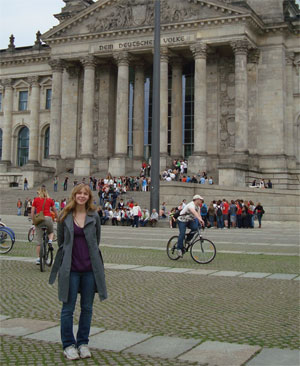 |
| Melissa Cernigoy at the Reichstag in Berlin. (Photo courtesy of Melissa Cernigoy) |
In late May of 2008, Melissa Cernigoy, a fourth-year Dalhousie student in international development and economics, spent 10 days visiting the Reichstag, Checkpoint Charlie, Plazow, Treblinka, Birkenau and Auschwitz. A participant on the “March of Remembrance and Hope,” a Holocaust and genocide study and leadership mission organized by the Canadian Centre for Diversity, she was accompanied by other Canadian and American students, as well as three Holocaust survivors.
SEE PHOTOS: March of Remembrance and Hope
Ms. Cernigoy, who had never before been to Europe, had less than a week to adjust to the unfamiliar continent before the group viewed Auschwitz.
“Displays and collections of shoes, eyeglasses, artifacts…. They have, like, rooms filled with these things,” she says. The group also saw the “office” of the notorious Joseph Mengele. “They had a room that had his operating table, and some of the equipment that he used. But it looked more like torture equipment.”
The students toured Warsaw, where pictures of deported families are hung in the windows of the preserved Jewish neighborhoods, and marched into the forest to visit the hidden mass graves of Holocaust victims. These are just the a few details of the trip: the itinerary was intense, both chronologically and emotionally.
No 'abnormal' reactions
How do students who have never left their homelands deal with the horrifying reminders of the Holocaust? Ms. Cernigoy is adamant that there is no way to prepare for the experience. Faced with the atrocities of history, students’ responses varied. “There were a lot of different reactions. Some people were making jokes, some people got very upset, some people couldn’t look at certain things… (The guides) always said that no reaction was abnormal to an abnormal situation… I didn’t feel like talking very much. I just felt like being quiet.”
Ms. Cernigoy is still very quiet—at times, discussing details, she is almost inaudible. It is clear where the “Remembrance” aspect of the march comes into play. What is less obvious is how this voyage could possibly inspire hope. However, Ms. Cernigoy is also candid about the trip’s happier moments, including a traditional dinner in a Berlin synagogue. “Everyone was really exhausted,” she says with a smile. “This one girl, she actually fell asleep while she was eating, which was pretty memorable.”
The students on the March of Remembrance and Hope also saw beautiful things, such as a 17th-century Polish synagogue miraculously spared by the ravages of war, and participants were encouraged to consider the most meaningful aspects of their own lives. Marching on foot from Auschwitz to Birkenau, a three-kilometre journey, each student inscribed their name tag with a “reason to march” – a personal symbol of hope on the journey ahead.
A lot has changed for Melissa Cernigoy since her return to Canadian soil. “I’ve always had an interest in history. A lot came out of this trip that I didn’t expect.” Ms. Cernigoy’s viewpoint on conventional “entertainment” has changed, for instance: she found the violence in a recent war blockbuster “so disturbing that I wanted to leave the theatre… I just don’t think that it’s funny. Maybe I would have before; I don’t know… I feel a lot more sensitive to violence. I’ve noticed that a lot. Like, even watching movies that are supposed to be entertaining.” Ms. Cernigoy is adamant, however, that the trip’s affirmative effects on her life have been most noticeable: she encourages students to undergo the March, a difficult, but life-changing, experience.
Bringing it home
Ms. Cernigoy tells me that students returning from the March of Remembrance and Hope are expected to remain active witnesses to what they’ve seen, engaging in activities in their communities that promote peace and tolerance. Since her arrival home, Ms. Cernigoy has been active in re-vitalizing Dalhousie’s SHOUT group. On Tuesday, Jan. 27, SHOUT Halifax, STAND and the Jewish Student Association are holding an event titled “Remembering Dachau to Defend Darfur.” The event will be held at 7 p.m. in Room 307 of the Dal SUB, and other events are planned in the future; the group is cooperative by nature and will frequently unite with other societies to plan their events.
“SHOUT is a very broad organization… we’re just getting ratified with the DSU.”
The 2009 March will be held from May 14-22; application information can be found on the Canadian Centre for Diversity’s website, www.centrefordiversity.ca, with a deadline of January 23, 2009.
As Ms. Cernigoy recounts her trip through Germany and Poland, neither of us mention perhaps the most frightening truth—that, at some time in the future, our generation will be the first to carry the memory of the Holocaust without the reminders of eyewitnesses. Remembrance will be the most important tool in learning from the devastating lessons of history. Hope has its place, too.
“At the closing ceremonies, I was singing this song,” she says with a laugh, “and I’m not a singer! But I was singing this song with three other girls. It was actually a Hebrew song, and I don’t know Hebrew… but they wanted me to sing with them, and so I just kind of learned the words phonetically.”
She pauses. “And so we were singing it, and as we were singing it, everyone was joining in. Nobody really knew the words, but they were all joining in, and everybody was clapping. And it was just this really overwhelming moment.”
She doesn’t know Hebrew, but Ms. Cernigoy does know the translation to the words of the song, when I ask: it’s ‘let peace begin with me.’
